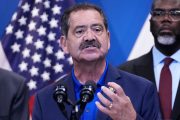President Trump signed an executive order on February 3 directing the secretary of the treasury to review financial regulations. The order is intended to be a first step toward rolling back the Obama-era Dodd-Frank Wall Street Reform and Consumer Protection Act.
Trump also signed an executive memorandum ordering a review of the Department of Labor’s Fiduciary Duty Rule, due to take effect in April, that would raise the standards of all financial professionals who work with retirement plans or provide retirement planning advice to the level of a fiduciary, a much higher level of accountability than previously required of financial salespersons, such as brokers, planners and insurance agents. The memorandum sets the stage for repealing or revising the Fiduciary Duty Rule.
At the beginning of a morning meeting with leading business leaders in the White House state dining room, Trump asked Rep. Ann Wagner (R-Mo.) to explain the the agenda. She said:
What we’re doing is we are returning to the American people, low- and middle-income investors, and retirees, their control of their own retirement savings. This is about Main Street, and it’s been a labor of love for me for over four years as [co] chairman [of the Republican National Committee]. And I have had — this is a big day, a big moment for Americans.
Trump said about Wagner, “And she means that so much.” He then signed the executive memorandum directing the secretary of Labor to delay in implementing the fiduciary rule.
Continuing with the meeting, Trump told those gathered:
There’s nobody better to tell me about Dodd-Frank than Jamie [Dimon, CEO of JPMorgan Chase], so you’re going to tell me about it. But we expect to be cutting a lot out of Dodd-Frank, because, frankly, I have so many people, friends of mine that have nice businesses that can’t borrow money, they just can’t get any money because the banks just won’t let them borrow because of the rules and regulations in Dodd-Frank. So we’ll be talking about that, Jamie, in terms of the banking industry.
Following the White House meeting, Trump signed his executive order to review financial regulations. Entitled “Presidential Executive Order on Core Principles for Regulating the United States Financial System,” this order could lead to rewriting major provisions of the Dodd-Frank Act — though it does not mention the act by name. However, one of the “core principles” in the order goes to the heart of correcting one of the worst failures of Dodd-Frank: “prevent taxpayer-funded bailouts.”
A report from CBS News noted about the executive order:
While Mr. Trump’s signed order won’t have any immediate impact, it directs the Treasury secretary to consult with members of different regulatory agencies and the Financial Stability Oversight Council and report back on potential changes.
The position of Treasury secretary is currently vacant, since Trump’s nominee for the cabinet post, Steve Mnuchin, has not yet been confirmed by the Senate. He is expected to receive a full Senate vote next week.
“We’re going to attack all aspects of Dodd-Frank,” Gary Cohn, director of the White House National Economic Council, said Friday in an interview with Bloomberg’s David Westin on Bloomberg Daybreak: Americas. “We are going to engage the House, we’re going to engage the Senate. They are equally interested in reforming some of the regulatory processes as well. We can do quite a bit without them, but the more help we get from Congress the better off we’re all going to be.”
A Bloomberg report about the Trump executive orders noted:
The Trump administration doesn’t believe Dodd-Frank measures, including the Volcker Rule limits on banks making speculative bets with their own funds, addressed real issues in the financial system, [a White House] official said. The president’s team also believes the Labor Department fiduciary rule was unnecessarily restricting investor choice without providing necessary consumer protection, the official said.
Writers for The New American have pointed out in the past that Dodd-Frank was never what it purported to be. For example, an article in 2012 noted that according to the text of the 2010 act, the law is supposed “to promote the financial stability of the United States by improving accountability and transparency in the financial system, to end ‘too big to fail,’ [and] to protect the American taxpayer by ending bailouts.”
However, noted our writer, as is usually the case with federal laws, Dodd-Frank does just the opposite or what it promised.
“In fact,” reports the New York Times’ Gretchen Morgenson, “Dodd-Frank actually widened the federal safety net for big institutions. Under that law, eight more giants were granted the right to tap the Federal Reserve for funding when the next crisis hits. At the same time, those eight may avoid Dodd-Frank measures that govern how we’re supposed to wind down institutions that get into trouble.”
A major built-in flaw of Dodd-Frank, the article quoted Peter Wallison of the American Enterprise Institute as saying, was that it supposedly prohibits the Fed from bailing out individual financial firms, it “permits the FSOC [the Financial Stability Oversight Council] to designate any financial institution that is engaged in clearing, settlement or payments activities — that is, almost every bank of any size — as eligible for a Federal Reserve bailout if its financial condition might prevent it from performing these functions. So with one hand the act took away bailout authority, but quietly, elsewhere in the act, this authority was fully restored.” [Emphasis in original.]
Last month, The New American published a list of 12 New Year’s resolutions for the new Congress. The 12th resolution was “Repeal Dodd-Frank.” A condensed summary of the reasons for doing so follows:
Dodd-Frank, passed in 2010 in response to the Great Recession, was … billed as the most sweeping set of financial reforms since the Great Depression, Dodd-Frank swept away a huge amount of financial freedom, imposing a suffocating web of regulations on every part of the financial sector, including insurance, investment banking, and even retailers who issue credit cards. As with all such legislation dating back to the 1930s, federal regulation of finance is not only unconstitutional but also a severe hindrance to the operation of the free market. Dodd-Frank has been an enormous factor limiting America’s ability to recover from the Great Recession. President Obama will leave office the first U.S. president since the Depression not to preside over at least one year with three percent growth, and he has had eight years to help mend the economy. But nearly every action taken by the Obama administration (and, in fairness, by the Bush administration before it) in response to the Great Recession — the bailouts, the tax hikes, and the new regulations, such as Dodd-Frank — has militated against a robust recovery, enlarging the size and power of the federal government at the expense of the private sector.
Note that the preceding article was a list of resolutions for Congress — not the president. As bad as Dodd-Frank is, it was passed by means of legislation and the Constitution requires that legislation, not executive actions, are necessary to repeal it. The Trump order can be viewed as a fact-finding mission, after which we can expect the president to make recommendations to Congress concerning the repeal of this detrimental law.
Photo of President Trump signing an executive order: AP Images
Related articles:
Dodd and Frank: The Dukes of Moral Hazard
If We Had Our way: New Year’s Resolutions for the New Congress




